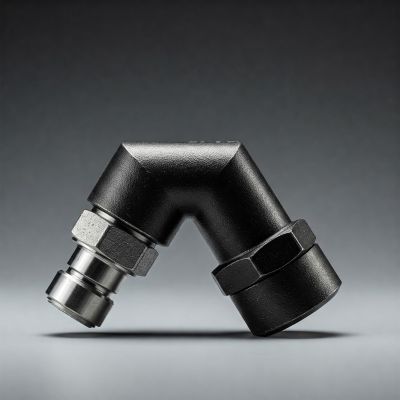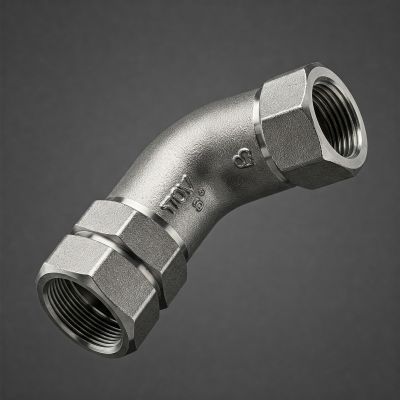Hydraulic fittings play a crucial role in fluid systems by ensuring secure and leak-proof connections. These fittings help direct fluid flow efficiently, maintain system pressure, and optimize performance. Among the various types of hydraulic fittings, elbow fittings are widely used to change the direction of fluid flow within a system.
There are two primary types of elbow fittings: Inverted Elbow and Standard Elbow. While both serve similar functions, their design, installation, and application differ significantly. This article compares the two fittings to help you determine which one best suits your hydraulic system needs.
What is an Inverted Elbow Hydraulic Fitting?
An inverted elbow hydraulic fitting is a specialized elbow fitting designed to provide a compact and efficient fluid flow transition in confined spaces. Unlike a standard elbow, the inverted elbow has a unique orientation that helps optimize fluid movement while maintaining system integrity.
How an Inverted Elbow Differs from a Standard Elbow
➡️ Orientation: The inverted elbow has a different bend geometry, making it suitable for specific layouts where traditional elbows may not fit.
➡️ Space Efficiency: Designed for tight spaces, the inverted elbow allows for better clearance in compact hydraulic systems.
➡️ Sealing Mechanism: Often features advanced sealing techniques to prevent leaks in high-pressure environments.
Common Applications and Industries
➡️ Automotive: Used in hydraulic braking and fuel systems.
➡️ Aerospace: Essential in fluid routing where space constraints exist.
➡️ Industrial Machinery: Found in compact hydraulic systems where traditional elbows would take up excessive space.
➡️ Marine Systems: Used in hydraulic steering and propulsion applications.
Advantages of Using an Inverted Elbow
➡️ Ideal for confined spaces where standard elbows are too bulky.
➡️ Reduces the risk of flow restrictions due to its unique curvature.
➡️ Offers better pressure resistance in high-demand applications.
What is a Standard Elbow Hydraulic Fitting?
A standard elbow hydraulic fitting is the most commonly used elbow fitting, designed to provide a simple and effective way to change the direction of fluid flow. It comes in 45-degree and 90-degree variations, making it adaptable to a wide range of applications.
Key Design Features of a Standard Elbow
➡️ Simple Curved Design: Standard elbows offer a smooth fluid transition while minimizing turbulence.
➡️ Variety of Angles: Available in 45-degree, 90-degree, and sometimes 180-degree configurations.
➡️ Threaded or Welded Connections: Options for easy installation based on system requirements.
Common Applications and Industries
➡️ Hydraulic Power Systems: Used in construction and agricultural machinery.
➡️ Oil and Gas Industry: Found in fluid transfer lines.
➡️ HVAC Systems: Helps regulate coolant flow in heating and cooling applications.
➡️ Manufacturing Plants: Used in automation and conveyor belt hydraulic systems.
Benefits of Standard Elbow Fittings
➡️ Easy to install and widely available.
➡️ Provides reliable directional changes in fluid systems.
➡️ Compatible with a broad range of hydraulic setups.
Key Differences Between Inverted Elbow and Standard Elbow Fittings
Design & Structure
➡️ Inverted Elbow: Features a unique orientation suited for confined spaces.
➡️ Standard Elbow: Has a traditional curved design suitable for general applications.
Flow Efficiency
➡️ Inverted Elbow: Provides better control over fluid movement in tight spaces.
➡️ Standard Elbow: Ensures smooth and steady flow transitions with minimal resistance.
Space & Installation
➡️ Inverted Elbow: Ideal for compact hydraulic layouts where space is limited.
➡️ Standard Elbow: Requires more space but offers easier installation.
Strength & Durability
➡️ Inverted Elbow: Often made from high-strength materials to withstand high-pressure environments.
➡️ Standard Elbow: Durable and reliable but may not be as pressure-resistant as an inverted elbow in certain applications.
Application Suitability
➡️ Inverted Elbow: Best suited for aerospace, automotive, and confined-space applications.
➡️ Standard Elbow: Used across multiple industries for general hydraulic flow redirection.
How to Choose the Right Hydraulic Elbow Fitting for Your Needs
Understanding System Pressure and Flow Requirements
➡️ Evaluate the pressure rating of your hydraulic system.
➡️ Choose a fitting that can handle the fluid flow without excessive turbulence.
Space Constraints and Fitting Orientation Considerations
➡️ If working in a tight space, an inverted elbow is the better choice.
➡️ For open layouts with sufficient clearance, a standard elbow is more practical.
Material Compatibility
➡️ Choose between stainless steel, brass, or aluminum based on your system’s corrosion resistance and pressure requirements.
Compliance with Industry Standards and Specifications
➡️ Ensure that the fitting meets SAE, ISO, or other relevant hydraulic standards.
Installation Tips for Inverted and Standard Elbow Fittings
Proper Alignment and Tightening Techniques
➡️ Align the fitting properly to prevent misalignment and leaks.
➡️ Use a torque wrench to tighten connections according to manufacturer specifications.
Common Mistakes to Avoid During Installation
➡️ Over-tightening, which can cause thread damage.
➡️ Using the wrong type of sealant, leading to leaks.
Best Practices for Maintaining Leak-Proof Connections
➡️ Regularly inspect fittings for wear and corrosion.
➡️ Apply thread sealant or Teflon tape when necessary.
Safety Tips When Working with Hydraulic Fittings
➡️ Always depressurize the system before installation.
➡️ Wear protective gloves and eyewear to prevent fluid exposure.
Common Issues and Troubleshooting
Leaks and Sealing Problems: Causes and Fixes
➡️ Cause: Improper tightening or damaged seals.
➡️ Fix: Replace the fitting or apply the correct sealant.
Wear and Corrosion: How to Extend Fitting Lifespan
➡️ Use corrosion-resistant materials.
➡️ Perform routine maintenance to identify early signs of wear.
Pressure Loss: Identifying and Solving Flow Inefficiencies
➡️ Ensure fittings are properly sized for the system.
➡️ Check for blockages or kinks in hydraulic lines.
Misalignment Issues: How to Ensure Proper Positioning
➡️ Use proper alignment tools.
➡️ Verify fitting angles before final tightening.
Conclusion
Understanding the key differences between inverted elbow and standard elbow hydraulic fittings is essential for making the right choice in fluid systems.
➡️ Inverted elbows are best for compact spaces and high-pressure environments.
➡️ Standard elbows are ideal for general use with easy installation.
Selecting the right fitting ensures better efficiency, durability, and performance in your hydraulic system. Whether you’re working in automotive, aerospace, industrial machinery, or HVAC systems, choosing the right elbow fitting can prevent costly failures and enhance system reliability.
By following the guidelines in this article, you can confidently select and install the elbow hydraulic fitting that best meets your operational needs. Either your needs are elbow like Female Metric L-Swivel 90° Elbow (24° Cone with O-Ring), or Female BSP Parallel Pipe – Swivel – 90° Elbow – (60° Cone) or etc.
Post time: Mar-26-2025



